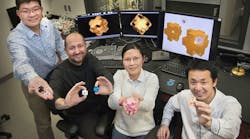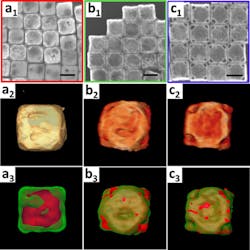Researchers Build “Nanowrappers” that can Carry and Release Nanoscale Cargo
An engineering team at the Center for Functional Nanomaterials (CFN) located in the Brookhaven National Laboratory have developed a one-step chemical synthesis method that lets them build hollow, metallic nanosized boxes and then used these “nanowrappers” to carry and release DNA-coated nanoparticles in a controlled way.
“Imagine you have a box, but can only use the outside and not the inside,” says team leader Oleg Gang. “This is how researchers have been dealing with nanoparticles. Most nanoparticle assembly or synthesis methods create solid nanostructures. We need methods that let us design and use the internal spaces of these structures.”
“Compared to their solid counterparts, hollow nanostructures have different optical and chemical properties that could be used for biomedical, sensing, and catalytic applications,” adds team member Fang Lu. “In addition, we can introduce surface openings in the hollow structures where materials such as drugs, biological molecules, and even nanoparticles can enter and exit, depending on the surrounding environment.”
Synthetic strategies have been developed to produce hollow nanostructures with surface pores, but typically the size, shape, and location of these pores cannot be well-controlled. The pores are randomly distributed across the surface, resulting in a Swiss cheese-like structure. Researchers needed a high level of control over surface openings to use nanostructures in practical applications such as loading and releasing nanocargo.
The team devised a method of chemically sculpturing gold-silver alloy nanowrappers with cube-shaped corner holes out of solid nanocube particles. It used nanoscale galvanic replacement, a chemical reaction in which atoms in the silver nanocube are replaced by gold ions in an aqueous solution at room temperature. To control the reaction, the team added a molecule (surfactant, or surface-capping agent) to the solution to direct how the silver was leached away and gold was deposited on specific crystalline facets.
The 3D structure and chemical composition characterizations of products obtained after five minutes (a), 20 minutes (b), and one hour (c). The scanning electron microscope images (subscript 1, scale bars are 100 nanometers), reconstructed 3D volume renderings (subscript 2), and 3D elemental mappings (subscript 3, gold in green and silver in red) show the transformation of silver nanocubes into gold-silver nanowrappers.
“Atoms on the faces of the cube are arranged differently from those in the corners, and thus different atomic planes are exposed, so the galvanic reaction cannot proceed the same way in both areas,” explains Lu. “The surfactant that binds to the silver surface is just strong enough so that the gold and silver can interact.
“Additionally, absorption of surfactant is relatively weak on the silver cube’s corners,” she adds. “The silver gets ‘eaten’ away from its edges, resulting in the formation of corner holes, while gold gets deposited on the rest of the surface to create a gold and silver shell.”
The scientists used electron microscopes to capture structural and chemical composition changes in the overall structure at the nanoscale in 3D, as well as at the atomic level in 2D, as the reaction proceeded over three hours. The 2D electron microscope images with energy-dispersive x-ray spectroscopy mapping confirmed the cubes were hollow and composed of a gold/silver alloy. The 3D images they obtained through electron tomography revealed that the hollow cubes had large cube-shaped holes at the corners.
“In electron tomography, 2D images collected at different angles are combined to reconstruct an image of an object in 3D,” says Gang. “The technique is similar to a computerized tomography scan used to image internal body structures, but it is carried out on a much smaller size scale and uses electrons instead of x-rays.”
The scientists also confirmed the nanocubes had been transformed into nanowrappers through spectroscopy. The spectra showed that the optical absorption of the nanowrappers can be tuned depending on the reaction time. At their final state, the nanowrappers absorb infrared light.
“The absorption spectrum showed a peak at 1250 nanometers, one of the longest wavelengths reported for nanoscale gold or silver,” notes Gang. “Typically, gold and silver nanostructures absorb visible light. However, we would like those particles to absorb infrared light for various applications such as phototherapy.”
Schematic for using the nanowrapper as a carrier to load and release a DNA-capped spherical nanoparticle. The blue and red on the direction arrow bars refer to low and high salt concentrations, respectively.
Using the synthesized nanowrappers, the scientists then demonstrated how spherical gold nanoparticles of an appropriate size that are capped with DNA could be loaded into and released from the corner openings by changing the concentration of salt in the solution. DNA is negatively charged (owing to the oxygen atoms in its phosphate backbone) and will changes its configuration in response to increasing or decreasing concentrations of a positively charged ion such as salt.
In high salt concentrations, DNA chains contract because their repulsion is reduced by the salt ions. In low salt concentrations, DNA chains stretch because their repulsive forces push them apart.
When the DNA strands contract, the nanoparticles become small enough to fit in the openings and enter the hollow cavity. The nanoparticles can be locked inside the nanowrapper by decreasing the salt concentration. At this lower concentration, the DNA strands stretch, thereby making the nanoparticles too large to go through the pores. The nanoparticles can leave the structure through a reverse process of increasing and decreasing the salt concentration.
“Our electron microscopy and optical spectroscopy studies confirmed that the nanowrappers can be used to load and release nanoscale components,” says Lu. “In principle, they could be used to release optically or chemically active nanoparticles in particular environments simply by changing other parameters such as pH or temperature.”
Going forward, the scientists are interested in assembling the nanowrappers into larger-scale architectures, extending their method to other bimetallic systems, and comparing the internal and external catalytic activity of the nanowrappers.
“We did not expect to see such regular, well-defined holes,” says Gang. “Usually, this level of control is quite difficult for nanoscale objects. Thus, our discovery of this new pathway of nanoscale structure formation could prove very useful.
“The ability to engineer nano-objects with a high level of control is important not only for understanding why certain processes are happening, but also for constructing targeted nanostructures for various applications,” he concludes. “Our new synthesis method opens up unique opportunities in these areas.”



